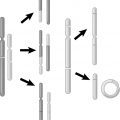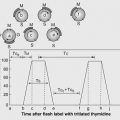14
IMPACT OF TIME, DOSE, AND FRACTIONATION IN RADIATION ONCOLOGY
DAESUNG LEE
Question 1
Biological effects of radiation on tissues depend on total dose, number of fractions, fraction size, and total time. However, not all tissues respond in the same way to changes in fraction size and overall treatment time, even if the total dose remains the same. When was it first realized that fractionation can be utilized to spare normal tissue better while achieving the desired effect of radiation?
Question 3
How does fractionation affect oxygenation in normal tissue and a tumor?
Question 1 Biological effects of radiation on tissues depend on total dose, number of fractions, fraction size, and total time. However, not all tissues respond in the same way to changes in fraction size and overall treatment time, even if the total dose remains the same. When was it first realized that fractionation can be utilized to spare normal tissue better while achieving the desired effect of radiation?
Answer 1
In the 1920s and 1930s, in France, radiation was thought to be a candidate for sterilization of rams to replace surgical castration, which had high morbidity rates. However, a single dose of radiation to sterilize rams also caused significant irritation of scrotum skin. When smaller fractionated doses were given over several days, sterilization was achieved while sparing scrotum skin, showing that biological effects can be differentially modulated among tissue types by varying dose, fractionation, and time.
Hall EJ, Giaccia AJ. Time, dose, and fractionation in radiotherapy. In: Hall EJ, Giaccia AJ, eds. Radiobiology for the Radiologist. 7th ed. Philadelphia, PA: Lippincott Williams & Wilkins, 2012:391–411.
Question 3 How does fractionation affect oxygenation in normal tissue and a tumor?
Answer 3
In normal tissue, oxygenation changes slightly, if any, between fractions. The tumor consists of aerated cells and hypoxic cells. A dose of radiation kills more aerated cells than hypoxic cells because aerated cells are more sensitive. Therefore, immediately after radiation treatment, the proportion of hypoxic cells increases because of a decrease in aerated cells killed by radiation. Then, there is reoxygenation of the remaining cells and the proportion of aerated cells return to the pretreatment level. Fractionation is one method to overcome hypoxia.
Halperin EC, Wazer DE, Perez CA. The discipline of radiation oncology. In: Halperin EC, Wazer DE, Perez CA, Brady LW, eds. Perez and Brady’s Principles and Practice of Radiation Oncology. 6th ed. Philadelphia, PA: Lippincott Williams & Wilkins; 2013:2–60.
Question 4
How does tumor cell killing improve oxygenation in the remaining cells?
Question 6
Redistribution means that cells in resistant phases of the cell cycle can move to a more sensitive phase at the next fraction. Does this improve the therapeutic ratio?
Question 4 How does tumor cell killing improve oxygenation in the remaining cells?
Answer 4
If there is a constant supply of oxygen, fewer surviving cells means better access to that amount of oxygen per each cell. Another possible mechanism is that blood vessels can be compressed by a rapidly growing cancer and they can be decompressed with tumor regression, resulting in better vascular and oxygen flow.
Halperin EC, Wazer DE, Perez CA. The discipline of radiation oncology. In: Halperin EC, Wazer DE, Perez CA, Brady LW, eds. Perez and Brady’s Principles and Practice of Radiation Oncology. 6th ed. Philadelphia, PA: Lippincott Williams & Wilkins; 2013:20.
Question 6 Redistribution means that cells in resistant phases of the cell cycle can move to a more sensitive phase at the next fraction. Does this improve the therapeutic ratio?
Answer 6
It would improve the therapeutic ratio if redistribution occurs in tumor cells and not in normal tissue stem cells. Tumor cells proliferate rapidly enough to move to different phases of the cell cycle between radiation fractions, but the normal tissue stem cells cycle slowly and stay mostly in the G0 phase of the cell cycle. However, in the cancer stem cell hypothesis, unlike cancer progenitor cells, cancer stem cells cycle slowly and it is not clear if redistribution gives a particularly strong advantage in cancer cure.
Pajonk F, Vlashi E, McBride WH. Radiation resistance of cancer stem cells: the 4 R’s of radiobiology revisited. Stem Cells. April 2010;28(4):639–648.
Question 7
Among the 4 R’s of radiobiology, which 2 R’s improve sparing of the normal tissues?
Question 9
What is accelerated repopulation?
Question 7 Among the 4 R’s of radiobiology, which 2 R’s improve sparing of the normal tissues?
Answer 7
Repair of sublethal damage between dose fractions and repopulation of normal tissue cells for sufficiently prolonged overall treatment time help improve sparing of normal tissues.
Hall EJ, Giaccia AJ. Time, dose, and fractionation in radiotherapy. In: Hall EJ, Giaccia AJ, eds. Radiobiology for the Radiologist. 7th ed. Philadelphia, PA: Lippincott Williams & Wilkins; 2012:391–411.
Question 9 What is accelerated repopulation?
Answer 9
Tumor growth and doubling time decrease with the growth of the tumor. With reduction of tumor cells by any cytotoxic agent such as radiation treatment and chemotherapy, surviving tumor clonogens are triggered to grow faster than the growth rate at the time of treatment initiation. This is called accelerated repopulation. It has a various lag time depending on tumor type. For human oropharygeal cancers, accelerated repopulation starts after about 1 month. This is when you start to see clinically significant repopulation, requiring an additional radiation dose to counter repopulation.
Hall EJ, Giaccia AJ. Time, dose, and fractionation in radiotherapy. In: Hall EJ, Giaccia AJ, eds. Radiobiology for the Radiologist. 7th ed. Philadelphia, PA: Lippincott Williams & Wilkins; 2012:391–411.
Kim JJ, Tannock IF. Repopulation of cancer cells during therapy: an important cause of treatment failure. Nat. Rev. Cancer. 2005;5:516–525.
Question 11
Repair of sublethal damage occurs in tumor cells as well as in normal cells. Does repair increase the therapeutic ratio in fractionated radiation treatment?
Question 13
Ellis improved on the Strandquist plot by separating overall treatment time and number of fractions and introduced the nominal standard dose (NSD) system with the following formula.
Total dose = (NSD)T 0.11N 0.24
where T is overall treatment time, N is the number of fractions, and NSD is a constant to adjust the unit to dose.
What are two major criticisms of this formula?
Question 11 Repair of sublethal damage occurs in tumor cells as well as in normal cells. Does repair increase the therapeutic ratio in fractionated radiation treatment?
Answer 11
Yes. Cancer cells were shown to have lower repair capacity of sublethal damage compared to normal cell lines in split-dose experiments where a single-dose radiation treatment to various cancer cell lines was compared to two split-dose radiation treatments administered 6 hours apart. Among normal tissues, late-responding tissue cells have more capacity for repair than early-responding tissue cells.
Schwachofer JH, Crooijmans RP, Hoogenhout J, et al. Sublethal damage repair in two radioresistant human tumor cell lines irradiated as multicellular spheroids. Tumour Biol. 1991;12(4):207–216.
Withers HR. Biologic basis for altered fractionation schemed. Cancer. 1985;55:2086–2095.
Stay updated, free articles. Join our Telegram channel

Full access? Get Clinical Tree






